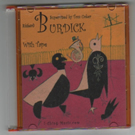
 Follow on Twitter
Follow on Twitter Richard Burdick
Richard BurdickHear the recording on BandCamp
Recorded in 2003
Avant guard multiphonic horn
multiphonic is the technique of singing & playing at the same time.
My Sculptures are a very important part of my compositional output as they are key pieces from several different periods in my compositional life. Sculpture I was written in 1980 and ‘81 when I was in college at California state University at Hayward studying with Glen Glassow. It contains the greatest amount of unusual techniques including singing and playing, stopped, inhaled falsetto and talking through the horn. The main aspect of these works is the multiphonics or singing and playing. Sculpture I contains my most favorite effect; that of singing and playing in unison and then gradually rising in pitch with my voice to the perfect pitch. The interference beats accelerate rapidly then gradually slow down to the still fifth. Sculpture I has a few fragments from Beethoven’s second symphony minuet.
Sculpture II is more fugal in nature written in 1982 and was originally a group of ten phrases to be played in any order but has solidified into my favorite order.
Sculpture III is the most difficult of the five having basically two different melodies which alternate as each time the multiphonic chords increase in size by a half step, so for the most part the are parallel intervals in the melodies, cadenza in the “normal’ horn instead of octaves. The is a phrase in this work that was latter used as the theme for the horn and organ work, opus 42.
Sculpture IV starts with the same opening phrase as Sculpture III since I started as a rewrite of the work. This work has two sets of slides the go with it, on projected on the performer and on a screen behind the horn player with some overlap. This work is much more of a mature work than the previous in that the phrases are more melodic. It was written entirely in the practice room with horn, which is very unusual for me since I write mostly on public transit in my spare time.
Sculpture V is based on a Byzantine chant which draws us to a logical conclusion, a transition from avante-guard to medieval, from chaotic to ordered.
“Moments when we see . . .” for horn and tape, opus 44 and “Electronic Birds” for solo tape also came from my work at California State University @ Hayward.
The birds piece was created by recording various sounds using the synthesizers with patch cords and overlapping them with real bird sounds. This reminds me of sound effects from the Tv show “Lost in Space”
"Moments . . " is more of a fully composed piece for horn and tape. It started again with recorded sounds from the electronic studio then feeding the tape through reel-to-reel players at very high speeds. The bulk of he piece is a study into the multiphonics on the horn growing from half step to the octave, which ends the piece.
Baroque shapes and space music (molto agitato) was written in a normal way and the tape part is played by my Mac computer. One of the interesting aspects of tape music is how fast the technology has changed. These computer sounds from around 1996 are already antiquated. This work is a molto agitato with lots of hard to hear high tones. Be carefully not to make any important decisions when listening to this piece.

874044002371